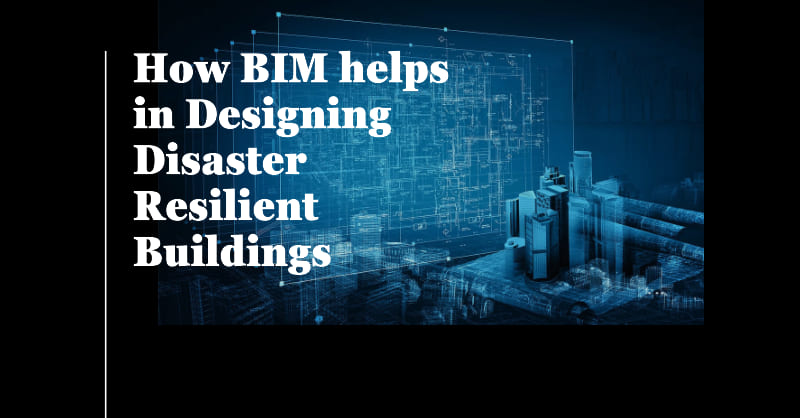How BIM Helps in Designing Disaster Resilient Buildings

Introduction
In an ever-changing world where natural disasters strike unexpectedly, causing devastating loss of life and property, it’s crucial to strengthen our buildings against these powerful forces. The combined cost of the 310 natural disasters recorded between 1980 and 2021 is more than $2.15 trillion. (NOAA Source) This highlights the long-term financial impact of these events. That’s where Building Information Modeling (BIM) comes in—a digital tool that’s revolutionizing how we design disaster-resistant structures. It has a range of capabilities that benefit various groups, from construction companies and architects to building owners and first responders. In this blog, we’ll focus on the role of digital twin models in creating resilient designs and navigating the challenges of unpredictable natural forces. Join us as we look into the intricacies of creating a safer and more secure future.
Uses and Advantages of virtual design and construction for creating disaster ready buildings
The use of digital models not only helps to make buildings stronger against upcoming disasters but also to reduce damage after adversity strikes. This approach gives architects and construction firms the ability to rethink building design, creating structures that combine great looks with strong resilience. In the next few sections we will learn about the different uses and advantages of using VDC.
Table of Contents
Detailed Information on Design, Construction, and Maintenance
Virtual construction models provide architects, designers, and construction companies with detailed information about the building’s design, construction, and maintenance. This information includes 3D models, specifications, material quantities, and schedules. By having access to this comprehensive data, stakeholders can make informed decisions and identify potential vulnerabilities in the building’s design that may pose risks during a disaster. It allows for better coordination and collaboration among the different disciplines involved in the construction process, ensuring that all aspects of the building are taken into account to enhance its resilience.
Simulating What-If Scenarios from the Planning Stage
One of the key advantages of digital models is the ability to simulate what-if scenarios from the planning stage itself. By using BIM software, architects and designers can create virtual models of the building and simulate various disaster scenarios, such as earthquakes, floods, or hurricanes. These simulations can help identify potential weaknesses in the design and allow for adjustments to be made to enhance the building’s resilience. For example, the simulations can help determine the optimal placement of structural elements, such as columns and beams, to withstand seismic forces or the best location for emergency exits and evacuation routes.
Improving Overall Quality and Disaster Preparedness
BIM can significantly improve the overall quality of the building and help achieve disaster preparedness goals. By providing detailed information on the building’s design, construction, and maintenance, it ensures that all aspects of the building are taken into consideration, including structural integrity, fire safety, and accessibility. This comprehensive approach helps minimize vulnerabilities and ensures that the building is better prepared to withstand and recover from a disaster.
Creating New Structures for Disaster Resilience
With VDC, architects and construction companies can create new structures that are built from the ground up for disaster resilience. By incorporating resilient design principles and using advanced simulation tools, it enables the creation of buildings that can withstand extreme weather events and other disasters. For example, optimizing the placement of windows and doors to minimize the risk of water infiltration during a flood or design structures with reinforced materials to withstand high winds.
An Essential Tool for Construction Companies and Disaster Responders
BIM is an essential tool for both construction companies and disaster responders. Construction companies can use it to design and construct buildings that are resilient to disasters, ensuring the safety of occupants and minimizing damage. On the other hand, disaster responders can utilize digital models to assess the impact of a disaster on existing buildings and infrastructure, plan rescue and recovery operations, and make informed decisions based on accurate and up-to-date information.
Enhancing the Seismic Building Design (SBD) Work Process
Digital construction can greatly enhance the seismic building design (SBD) work process. By using BIM Modeling Services, engineers and designers can analyze the structural behavior of buildings under seismic forces and optimize the design accordingly. It allows for the integration of seismic design codes and standards, ensuring that buildings are designed to withstand earthquakes and other seismic events.
Integrating Resilient Design Elements
Architectural BIM Services can be used to integrate resilient design elements into buildings, making them more resistant to future disasters. For example, it can help incorporate features such as flood-resistant materials, elevated foundations, and green building design to mitigate the impact of floods. By considering these design elements in the early stages of the project, we can create buildings that are better prepared to face future challenges.
Conclusion
In conclusion virtual construction is a game-changer in a world that is prone to tragedies. It gives us the tools we need to create structures that are incredibly resilient and to react to disasters. It paves the path for safer structures and faster recoveries by simulating situations, improving designs, and encouraging collaboration. BIM’s importance will only increase in the future. With the development of technology, resilient building is set to become the cornerstone, guaranteeing that our constructions not only survive but also prosper in the face of adversity.